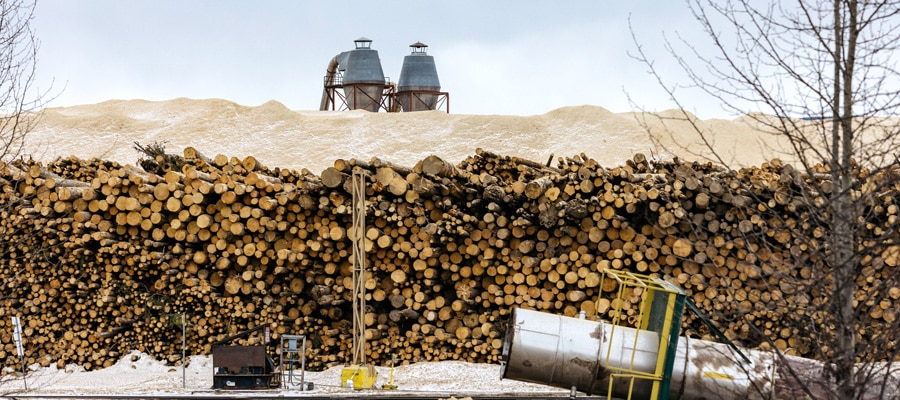Pat Bell’s YouTube Foray – Sowing Seeds of Misinformation
Unlikely as it is to garner a huge following on YouTube, one suspects a recently uploaded video message by B.C. Forests Minister Pat Bell may soon have more than a few forest industry workers, commercial tree nursery owners and members of Bell’s own ministry shaking their heads in disbelief.
Under the pretext of kicking off “national forestry week”, Bell waxes enthusiastically about how B.C.’s forest industry “is a really exciting place to be right now.” Yes, the minister and MLA for Prince George-Mackenzie says, we’re “maximizing” the value from our forests like never before, “using more and more of each tree.” And we’re renewing our forests, by planting plenty of new trees for future generations.
So let’s get this straight. Ten years ago, B.C.’s forest industry employed 99,000 men and women, nearly half of whom worked in mills making solid wood products, which is where we get the biggest bang for the buck not only from an employment perspective but a climate perspective as well (remember, all solid wood products continue to store carbon for decades and potentially generations to come). A decade later, and we’re down to 52,000 industry jobs – a whopping 47% percent decline. If this is exciting, I’d hate to see what depressing looks like.
Bell, of course, doesn’t stray anywhere near such uncomfortable truths. Instead, he stays focused on his short, scripted video message which, among other things, touts the great job potential associated with churning out more wood pellets in B.C. – pellets that are shipped half way around the world to heat homes and businesses in Europe, and which European countries subsequently claim carbon credit for on the shaky ground that the pellets are “carbon neutral” and displace the burning of dirty coal or other non-renewable fossil fuels. Or Bell alludes to burning more of our forest resources to fire new electrical plants as part of BC Hydro’s “Phase 2” call for new electricity from so-called “bioenergy” sources.
If the Forests Minister seriously thinks that this represents a potentially significant source of new jobs in the province he ought to give his head a shake. While a new wood pellet plant slated for Burns Lake will create 20 new badly needed full-time jobs, the jobs created will require staggering amounts of wood to be sustained. For each job in the pellet plant approximately 13,250 standard telephone pole’s worth of wood will have to be found. This compares to one job for every 1,000 cubic metres of wood, which more or less has been B.C.’s average over the past couple of decades. An average, by the way, that is far from the envy of the world, with many other countries having consistently outperformed B.C. by generating far more jobs with far less wood.
From a sustainable management perspective, accelerating wood pellet production is not the answer to our problems. It creates relatively few jobs while producing a product that is immediately burned, releasing greenhouse gases into the Earth’s overheating atmosphere. This should not preclude using wood as an energy or heat source. But surely, we ought to embrace job growth strategies centered on making durable, high-value, solid wood products first, with only the fallout or waste from those processes being potentially available for use as heat and power sources. And only then, in a context of a healthy carbon balance in our forests and forest products over time – as both forest industry unions and environmental organizations in the province have advocated. As will come as little surprise, Bell goes nowhere near this, perhaps because to do so would be to confront those ugly job loss figures earlier noted.
And then there’s the small matter of renewing British Columbia’s publicly owned forests.
Here, it’s hard to gauge whether the informed viewer will laugh or cry at Bell’s YouTube performance. “We planted an additional 20 million trees this year through our Forests for Tomorrow program,” Bell enthuses. “We’re looking at new and innovative ways of growing trees faster and making sure that we have a sustainable timber supply for our children and our grandchildren.”
Sinking 20 million new trees into the ground may sound impressive. But as Rob Scagel, a consultant to tree-planting companies and commercial nursery operators puts it, “that’s not even a necktie for a corpse.”
There are many individual nurseries in the province, Scagel says, that could sow 20 million seedlings and have space to spare. Go back in time, Scagell adds, and you will find a wealth of statistical data to show that in the late 1980s and 1990s publicly funded reforestation programs sank five times as many trees into the ground, helping not only to renew public resources but provide much sought after seasonal employment to corps of workers, many of them university students wrestling with escalating tuition fees. And that wasn’t the half of it. Funds were also available in the tens of millions of dollars to brush, thin and prune forests, funds which are nowhere to be seen today.
All of that past investment came well before the most recent and epic pine beetle attack; the massive amount of logging that has occurred in response to that attack; and a rash of severe forest fire seasons that burned across hundreds of thousands of hectares of public forestland.
When all of those things and more are considered, Anthony Britneff a former Ministry of Forests employee with nearly four decades of public service behind him, says the province faces a reforestation challenge of unprecedented proportions.
Instead of sowing seeds for more trees, Bell chooses to sow seeds of misinformation. Our forests and forest industry are both the poorer for it.
Topics: Climate change & energy policy, Economy, Employment & labour, Environment, resources & sustainability


